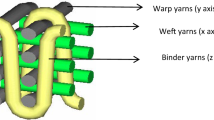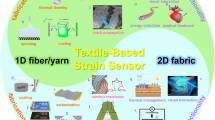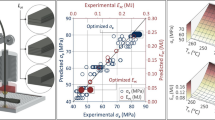Abstract
The friction between twisted yarns during the process of manufacturing textile reinforcements has been considered an important issue that can strongly influence the mechanical properties of the preform, which deteriorate the mechanical characteristics of fiber-reinforced composites if the friction is excessive. Based on Hertzian contact theory, a novel analytical model has been developed in this research to describe the friction behavior between the twisted yarns in orthogonal and non-orthogonal contact. The realistic contact area was modeled under micro/meso scales taking into account the contact angle between the yarns and the orientation of the fibers influenced by the twist. The efficacy of the developed model was confirmed by the experimental approach. Through the developed model, the yarn/yarn friction behaviors were characterized under different conditions considering the weaving process, such as orthogonal and non-orthogonal contact, same/different twist level, and same/different twist direction, which is essential for optimizing the textile preform forming process and enhancing the mechanical properties of the composites.














Similar content being viewed by others
Data Availability
The raw and experimental data required to reproduce these studies can be shared on request.
Abbreviations
- F f :
-
Friction force (N)
- COF :
-
Coefficient of friction
- A r/yarn :
-
Realistic contact area of yarn (m2)
- A r/fiber :
-
Realistic contact area of fiber (m2)
- F n :
-
Normal load in \(\overrightarrow{n}\) (N)
- F t :
-
Tangential load of yarn (N)
- α :
-
Angle between fiber axes (°)
- β :
-
Angle between yarn axes (°)
- γ :
-
Twist angle of yarn (°)
- θ :
-
Angle between z \(\left(\overrightarrow{z}\right)\) and normal \(\left(\overrightarrow{n}\right)\) directions (°)
- r f :
-
Radius of fiber (m)
- R :
-
Radius of yarn (m)
- R * :
-
Equivalent radius of fiber (m)
- E * :
-
Equivalent Young’s modulus of fiber (Pa)
- E :
-
Young’s modulus of fiber (Pa)
- ν :
-
Poisson’s ratio of fiber
- R’ :
-
Major relative radius of curvature of the contact surface
- R’’ :
-
Minor relative radius of curvature of the contact surface
- τ :
-
Shear strength (Pa)
- H :
-
Displacement under the action of F
- f N :
-
Normal load of fiber (N)
- n :
-
Number of contact fibers in width of upper yarn
- m :
-
Number of contact fibers in width of lower yarn
- T t :
-
Twist of yarn (tpm)
- h i :
-
Distance between the fibers (m)
- b :
-
Half-width of the contact (m)
- E l :
-
Longitudinal modulus of yarn (Pa)
- E t :
-
Transverse modulus of yarn (Pa)
- v 12 :
-
Poisson’s ratio of yarn
- F :
-
Applied normal force in \(\overrightarrow{z}\) (N)
- F p :
-
Pre-tension of yarn (N)
- l :
-
Length of twisted yarn sample (m)
- k :
-
Fitting coefficient
- a :
-
Span of sample (m)
- u :
-
Distance between contact point and center of span (m)
References
Xie, J., Guo, Z., Shao, M., Zhu, W., Jiao, W., Yang, Z., Chen, L.: Mechanics of textiles used as composite preforms: a review. Compos. Struct. 304, 116401 (2023). https://doi.org/10.1016/j.compstruct.2022.116401
Gao, Z., Chen, L.: A review of multi-scale numerical modeling of three-dimensional woven fabric. Compos. Struct. 263, 113685 (2021). https://doi.org/10.1016/j.compstruct.2021.113685
Xiao, S., Gao, H., Soulat, D., Wang, P.: A revised model of kinematic analysis on in-plane shearing behaviour of biaxial fabrics in bias extension test. Composites A (2022). https://doi.org/10.1016/j.compositesa.2022.107251
Gnaba, I., Legrand, X., Wang, P., Soulat, D.: Through-the-thickness reinforcement for composite structures: a review. J. Ind. Text. 49, 71–96 (2019). https://doi.org/10.1177/1528083718772299
Li, M., Wang, P., Boussu, F., Soulat, D.: A review on the mechanical performance of three-dimensional warp interlock woven fabrics as reinforcement in composites. J. Ind. Text. 51, 1009–1058 (2022). https://doi.org/10.1177/1528083719894389
Yang, Z., Jiao, Y., Xie, J., Chen, L., Jiao, W., Li, X., Zhu, M.: Modeling of 3D woven fibre structures by numerical simulation of the weaving process. Compos. Sci. Technol. 206, 108679 (2021). https://doi.org/10.1016/j.compscitech.2021.108679
Hui, C., Wang, P., Legrand, X.: Improvement of tufting mechanism during the advanced 3-dimensional tufted composites manufacturing: to the optimisation of tufting threads degradation. Compos. Struct. 220, 423–430 (2019). https://doi.org/10.1016/j.compstruct.2019.04.019
Wang, Y., Jiao, Y., Wu, N., Xie, J., Chen, L., Wang, P.: An efficient virtual modeling regard to the axial tensile and transverse compressive behaviors of the twisted yarns. J. Ind. Text. 52, 15280837221137352 (2022). https://doi.org/10.1177/15280837221137353
Simon, J., Hamila, N., Binetruy, C., Comas-Cardona, S., Masseteau, B.: Design and numerical modelling strategy to form tailored fibre placement preforms: application to the tetrahedral part with orthotropic final configuration. Composites A 158, 106952 (2022). https://doi.org/10.1016/j.compositesa.2022.106952
Wang, Y., Li, X., Xie, J., Wu, N., Jiao, Y., Wang, P.: Numerical and experimental investigation on bending behavior for high-performance fiber yarns considering probability distribution of fiber strength. Textiles 3, 129–141 (2023). https://doi.org/10.3390/textiles3010010
Abtew, M.A., Boussu, F., Bruniaux, P., Loghin, C., Cristian, I., Chen, Y., Wang, L.: Yarn degradation during weaving process and its effect on the mechanical behaviours of 3D warp interlock p-aramid fabric for industrial applications. J. Ind. Text. (2020). https://doi.org/10.1177/1528083720937288
Hemmer, J., Lectez, A.-S., Verron, E., Lebrun, J.-M., Binetruy, C., Comas-Cardona, S.: Influence of the lateral confinement on the transverse mechanical behavior of tows and quasi-unidirectional fabrics: experimental and modeling investigations of dry through-thickness compaction. J. Compos. Mater. 54, 3261–3274 (2020). https://doi.org/10.1177/0021998320912809
Cornelissen, B., de Rooij, M.B., Rietman, B., Akkerman, R.: Frictional behaviour of high performance fibrous tows: a contact mechanics model of tow–metal friction. Wear 305, 78–88 (2013). https://doi.org/10.1016/j.wear.2013.05.014
Abu Obaid, A., Gillespie, J.: Effects of abrasion on mechanical properties of Kevlar KM2-600 and S glass tows. Text. Res. J. 89, 989–1002 (2019). https://doi.org/10.1177/0040517518760753
Archer, E., Buchanan, S., McIlhagger, A., Quinn, J.: The effect of 3D weaving and consolidation on carbon fiber tows, fabrics, and composites. J. Reinf. Plast. Compos. 29, 3162–3170 (2010). https://doi.org/10.1177/0731684410371405
Smerdova, O., Benchekroun, O., Brunetiere, N.: Transversal friction of epoxy-lubricated and dry carbon tows: from initial stages to stabilised state. Composites A 143, 106263 (2021). https://doi.org/10.1016/j.compositesa.2020.106263
Gupta, B.S.: Friction in textile materials. Elsevier, Amsterdam (2008)
Dackweiler, M., Hagemann, L., Coutandin, S., Fleischer, J.: Experimental investigation of frictional behavior in a filament winding process for joining fiber-reinforced profiles. Compos. Struct. 229, 111436 (2019). https://doi.org/10.1016/j.compstruct.2019.111436
Sugimoto, Y., Shimamoto, D., Hotta, Y.: Evaluation of kinetic friction coefficients between single carbon fibers. Carbon 167, 264–269 (2020). https://doi.org/10.1016/j.carbon.2020.06.010
Engelfried, M., Aichele, B., Middendorf, P.: Investigation of the friction between dry and wetted carbon filaments. Procedia Manuf. 47, 60–64 (2020). https://doi.org/10.1016/j.promfg.2020.04.130
Cornelissen, B., Sachs, U., Rietman, B., Akkerman, R.: Dry friction characterisation of carbon fibre tow and satin weave fabric for composite applications. Composites A 56, 127–135 (2014). https://doi.org/10.1016/j.compositesa.2013.10.006
Mulvihill, D.M., Sutcliffe, M.P.F.: Effect of tool surface topography on friction with carbon fibre tows for composite fabric forming. Composites A 93, 199–206 (2017). https://doi.org/10.1016/j.compositesa.2016.10.017
Roselman, I.C., Tabor, D.: The friction and wear of individual carbon fibres. J. Phys. Appl. Phys. 10, 1181–1194 (1977). https://doi.org/10.1088/0022-3727/10/8/018
Xiang, Z., Liu, Y., Zhou, X., Wu, Z., Hu, X.: Interlayer contact mechanism of the frictional behavior of glass-fiber woven fabrics and improvements of winding characteristics. Compos. Struct. 233, 111497 (2020). https://doi.org/10.1016/j.compstruct.2019.111497
Shanwan, A., Gassara, H.-E., Barbier, G., Sinoimeri, A.: New experimental device for measuring the inter-fiber transversal friction. IOP Conf. Ser. Mater. Sci. Eng. 254, 142020 (2017). https://doi.org/10.1088/1757-899X/254/14/142020
Gassara, H.E., Barbier, G., Wagner Kocher, C., Sinoimeri, A., Pumo, B.: Experimental evaluation of transverse friction between fibers. Tribol. Int. 119, 112–122 (2018). https://doi.org/10.1016/j.triboint.2017.10.035
Tourlonias, M., Bueno, M.-A., Jordan, C., Poquillon, D.: Influence of wear on the sizing layer and desizing of single carbon fibre-to-fibre friction. Wear 402–403, 64–70 (2018). https://doi.org/10.1016/j.wear.2018.02.003
Smerdova, O., Sutcliffe, M.P.F.: Multiscale tool–fabric contact observation and analysis for composite fabric forming. Composites A 73, 116–124 (2015). https://doi.org/10.1016/j.compositesa.2015.03.009
Tourlonias, M., Bueno, M.-A.: Experimental simulation of friction and wear of carbon yarns during the weaving process. Composites A 80, 228–236 (2016). https://doi.org/10.1016/j.compositesa.2015.07.024
Salem, M.M., De Luycker, E., Delbe, K., Fazzini, M., Ouagne, P.: Experimental investigation of vegetal and synthetic fabrics cohesion in order to prevent the tow sliding defect via frictional and pull-out test. Composites A 139, 106083 (2020). https://doi.org/10.1016/j.compositesa.2020.106083
Ismail, N., de Rooij, M.B., de Vries, E.G., Zini, N.H.M., Schipper, D.J.: Friction between single aramid fibres under pre-tension load. Tribol. Int. 137, 236–245 (2019). https://doi.org/10.1016/j.triboint.2019.04.013
Roselman, I.C., Tabor, D.: The friction of carbon fibres. J. Phys. Appl. Phys. 9, 2517 (1976). https://doi.org/10.1088/0022-3727/9/17/012
Howell, H.G., Mazur, J.: Amontons’ law and fibre friction. J. Text. Inst. Trans. 44, T59–T69 (1953). https://doi.org/10.1080/19447025308659728
Bowden, F.P., Leben, L.: The nature of sliding and the analysis of friction. Proc. R. Soc. Lond. Ser. Math. Phys. Sci. 169, 371–391 (1939). https://doi.org/10.1098/rspa.1939.0004
He, C., Ge, J., Chen, Y., Lian, Y.: Concurrent multiscale virtual testing for 2D woven composite structures: a pathway towards composites design and structure optimization. Compos. Struct. (2022). https://doi.org/10.1016/j.compstruct.2022.116406
Wu, N., Xie, X., Yang, J., Feng, Y., Jiao, Y., Chen, L., Xu, J., Jian, X.: Effect of normal load on the frictional and wear behaviour of carbon fiber in tow-on-tool contact during three-dimensional weaving process. J. Ind. Text. (2020). https://doi.org/10.1177/1528083720944615
Tourlonias, M., Bueno, M.-A., Fassi, G., Aktas, I., Wielhorski, Y.: Influence of friction angle between carbon single fibres and tows: experimental analysis and analytical model. Composites A 124, 105478 (2019). https://doi.org/10.1016/j.compositesa.2019.105478
Tourlonias, M., Bueno, M.-A., Poquillon, D.: Friction of carbon tows and fine single fibres. Composites A 98, 116–123 (2017). https://doi.org/10.1016/j.compositesa.2017.03.017
Li, M., Wang, P., Boussu, F., Soulat, D.: Investigation of impact performance of 3-dimensional interlock polymer fabrics in double and multi-angle pass stabbing. Mater. Des. 206, 109775 (2021). https://doi.org/10.1016/j.matdes.2021.109775
He, Y., Jiao, Y., Zhou, J.Q., Lei, H., Jia, N., Chen, L., Zhang, D.: Ballistic response of ultra-high molecular weight polyethylene laminate impacted by mild steel core projectiles. Int. J. Impact Eng. 169, 104338 (2022). https://doi.org/10.1016/j.ijimpeng.2022.104338
Bazan, P., Mierzwiński, D., Bogucki, R., Kuciel, S.: Bio-based polyethylene composites with natural fiber: mechanical, thermal, and ageing properties. Materials 13, 2595 (2020). https://doi.org/10.3390/ma13112595
Han, L., Cai, H., Chen, X., Zheng, C., Guo, W.: Study of UHMWPE fiber surface modification and the properties of UHMWPE/epoxy composite. Polymers 12, 521 (2020). https://doi.org/10.3390/polym12030521
Popov, V.L.: Rigorous treatment of contact problems—hertzian contact. In: Popov, V.L. (ed.) Contact mechanics and friction: physical principles and applications, pp. 57–81. Springer, Berlin (2017)
Kawabata, S.: Measurement of the transverse mechanical properties of high-performance fibres. J. Text. Inst. 81, 432–447 (1990). https://doi.org/10.1080/00405009008658721
Walther, J., Bessette, C., Decrette, M., Tourlonias, M., Bueno, M.-A., Osselin, J.-F., Charleux, F., Coupé, D.: Yarn damage conditions due to interactions during interlock weaving process: in-situ and in-lab experiments. Appl. Compos. Mater. 29, 245–262 (2022). https://doi.org/10.1007/s10443-021-09950-7
Daelemans, L., Tomme, B., Caglar, B., Michaud, V., Van Stappen, J., Cnudde, V., Boone, M., Van Paepegem, W.: Kinematic and mechanical response of dry woven fabrics in through-thickness compression: virtual fiber modeling with mesh overlay technique and experimental validation. Compos. Sci. Technol. 207, 108706 (2021). https://doi.org/10.1016/j.compscitech.2021.108706
Acknowledgements
The authors gratefully acknowledge: the financial support from the China Scholarship Council (CSC 202108120054).
Author information
Authors and Affiliations
Contributions
YW: investigation, methodology, theoretical analysis, experimental analysis, validation, visualization and writing—original draft. YJ: project administration, supervision, validation and review & editing. PW: project administration, supervision, methodology, formal analysis, validation and writing—review & editing.
Corresponding author
Ethics declarations
Conflict of interest
The authors declare that they have no known competing financial interests or personal relationships that could have appeared to influence the work reported in this paper.
Additional information
Publisher's Note
Springer Nature remains neutral with regard to jurisdictional claims in published maps and institutional affiliations.
Appendix A
Appendix A
The changing relationships between θ and displacement H under the action of F are detailed in this appendix. All parameters are shown in Fig. 15. The applied normal force F in the kinematic friction process can be further calculated by tension acting on the lower yarn T through the following equations:
where El is the longitudinal modulus of yarn, S is the area of yarn’s cross section, and Fp is the initial pre-tension applied to yarn.
where l is the length of the yarn sample involved in friction which is obtained from the experiment. Moreover, θ1 and θ2 are given as
where H is displacement under the action of F, which can have a relationship using θ1 and θ2 see Eq. (14):
The description of dimensional parameters during the friction process based on Fig. 5
Rights and permissions
Springer Nature or its licensor (e.g. a society or other partner) holds exclusive rights to this article under a publishing agreement with the author(s) or other rightsholder(s); author self-archiving of the accepted manuscript version of this article is solely governed by the terms of such publishing agreement and applicable law.
About this article
Cite this article
Wang, Y., Jiao, Y. & Wang, P. Yarn/Yarn Friction Analysis Considering the Weaving Process of Textile Fabrics: Analytical Model and Experimental Validation. Tribol Lett 71, 91 (2023). https://doi.org/10.1007/s11249-023-01755-y
Received:
Accepted:
Published:
DOI: https://doi.org/10.1007/s11249-023-01755-y





